Management Accounting: Planning Tools and Financial Shortfalls
VerifiedAdded on 2020/01/23
|12
|2629
|219
Report
AI Summary
This report delves into the multifaceted world of management accounting, examining the crucial role it plays in organizational decision-making. It explores various planning methods like budgetary control, variance analysis, and fixed budgets, highlighting their merits and limitations in managing and controlling financial aspects. The report analyzes different budgeting tools, including cash, sales, production, and raw material budgets, showcasing their application in forecasting financial data. It evaluates how companies adapt management accounting systems to resolve financial shortfalls, tracing the historical evolution of these systems and identifying key financial issues. Furthermore, the report examines diverse management accounting approaches, such as financial governance, budgetary control, key performance indicators, and benchmarking, emphasizing their supportive role in mitigating financial problems. The conclusion underscores the significance of planning tools and management accounting systems in achieving financial objectives and addressing financial challenges.

MANAGEMENT
ACCOUNTING
ACCOUNTING
Paraphrase This Document
Need a fresh take? Get an instant paraphrase of this document with our AI Paraphraser

TABLE OF CONTENTS
INTRODUCTION...........................................................................................................................1
P4 Explaining merits and limitations of various kinds of the planning methods considered by
management to control over the budgetary............................................................................1
M3 Analysing planning tools along with its application........................................................3
P5 Evaluating how companies adapting systems of management accounting for resolving
financial shortfalls..................................................................................................................6
M4 Analysis that how financial issues can be resolve within organisation by using
management accounting (MA) systems.................................................................................7
D3 Analysing that how planning tools supportive to eliminate financial issues....................8
CONCLUSION................................................................................................................................8
REFERENCES................................................................................................................................9
INTRODUCTION...........................................................................................................................1
P4 Explaining merits and limitations of various kinds of the planning methods considered by
management to control over the budgetary............................................................................1
M3 Analysing planning tools along with its application........................................................3
P5 Evaluating how companies adapting systems of management accounting for resolving
financial shortfalls..................................................................................................................6
M4 Analysis that how financial issues can be resolve within organisation by using
management accounting (MA) systems.................................................................................7
D3 Analysing that how planning tools supportive to eliminate financial issues....................8
CONCLUSION................................................................................................................................8
REFERENCES................................................................................................................................9
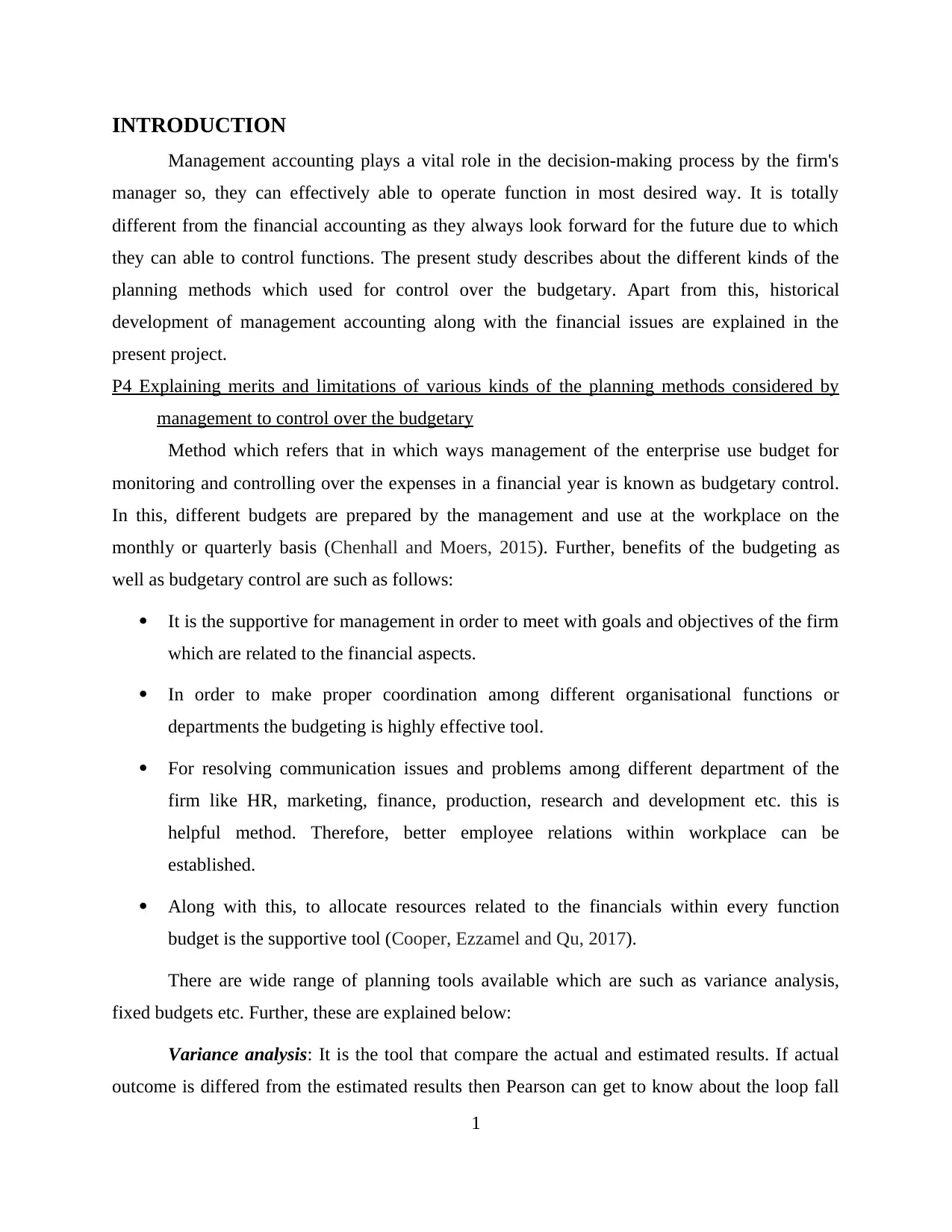
INTRODUCTION
Management accounting plays a vital role in the decision-making process by the firm's
manager so, they can effectively able to operate function in most desired way. It is totally
different from the financial accounting as they always look forward for the future due to which
they can able to control functions. The present study describes about the different kinds of the
planning methods which used for control over the budgetary. Apart from this, historical
development of management accounting along with the financial issues are explained in the
present project.
P4 Explaining merits and limitations of various kinds of the planning methods considered by
management to control over the budgetary
Method which refers that in which ways management of the enterprise use budget for
monitoring and controlling over the expenses in a financial year is known as budgetary control.
In this, different budgets are prepared by the management and use at the workplace on the
monthly or quarterly basis (Chenhall and Moers, 2015). Further, benefits of the budgeting as
well as budgetary control are such as follows:
It is the supportive for management in order to meet with goals and objectives of the firm
which are related to the financial aspects.
In order to make proper coordination among different organisational functions or
departments the budgeting is highly effective tool.
For resolving communication issues and problems among different department of the
firm like HR, marketing, finance, production, research and development etc. this is
helpful method. Therefore, better employee relations within workplace can be
established.
Along with this, to allocate resources related to the financials within every function
budget is the supportive tool (Cooper, Ezzamel and Qu, 2017).
There are wide range of planning tools available which are such as variance analysis,
fixed budgets etc. Further, these are explained below:
Variance analysis: It is the tool that compare the actual and estimated results. If actual
outcome is differed from the estimated results then Pearson can get to know about the loop fall
1
Management accounting plays a vital role in the decision-making process by the firm's
manager so, they can effectively able to operate function in most desired way. It is totally
different from the financial accounting as they always look forward for the future due to which
they can able to control functions. The present study describes about the different kinds of the
planning methods which used for control over the budgetary. Apart from this, historical
development of management accounting along with the financial issues are explained in the
present project.
P4 Explaining merits and limitations of various kinds of the planning methods considered by
management to control over the budgetary
Method which refers that in which ways management of the enterprise use budget for
monitoring and controlling over the expenses in a financial year is known as budgetary control.
In this, different budgets are prepared by the management and use at the workplace on the
monthly or quarterly basis (Chenhall and Moers, 2015). Further, benefits of the budgeting as
well as budgetary control are such as follows:
It is the supportive for management in order to meet with goals and objectives of the firm
which are related to the financial aspects.
In order to make proper coordination among different organisational functions or
departments the budgeting is highly effective tool.
For resolving communication issues and problems among different department of the
firm like HR, marketing, finance, production, research and development etc. this is
helpful method. Therefore, better employee relations within workplace can be
established.
Along with this, to allocate resources related to the financials within every function
budget is the supportive tool (Cooper, Ezzamel and Qu, 2017).
There are wide range of planning tools available which are such as variance analysis,
fixed budgets etc. Further, these are explained below:
Variance analysis: It is the tool that compare the actual and estimated results. If actual
outcome is differed from the estimated results then Pearson can get to know about the loop fall
1
⊘ This is a preview!⊘
Do you want full access?
Subscribe today to unlock all pages.

Trusted by 1+ million students worldwide
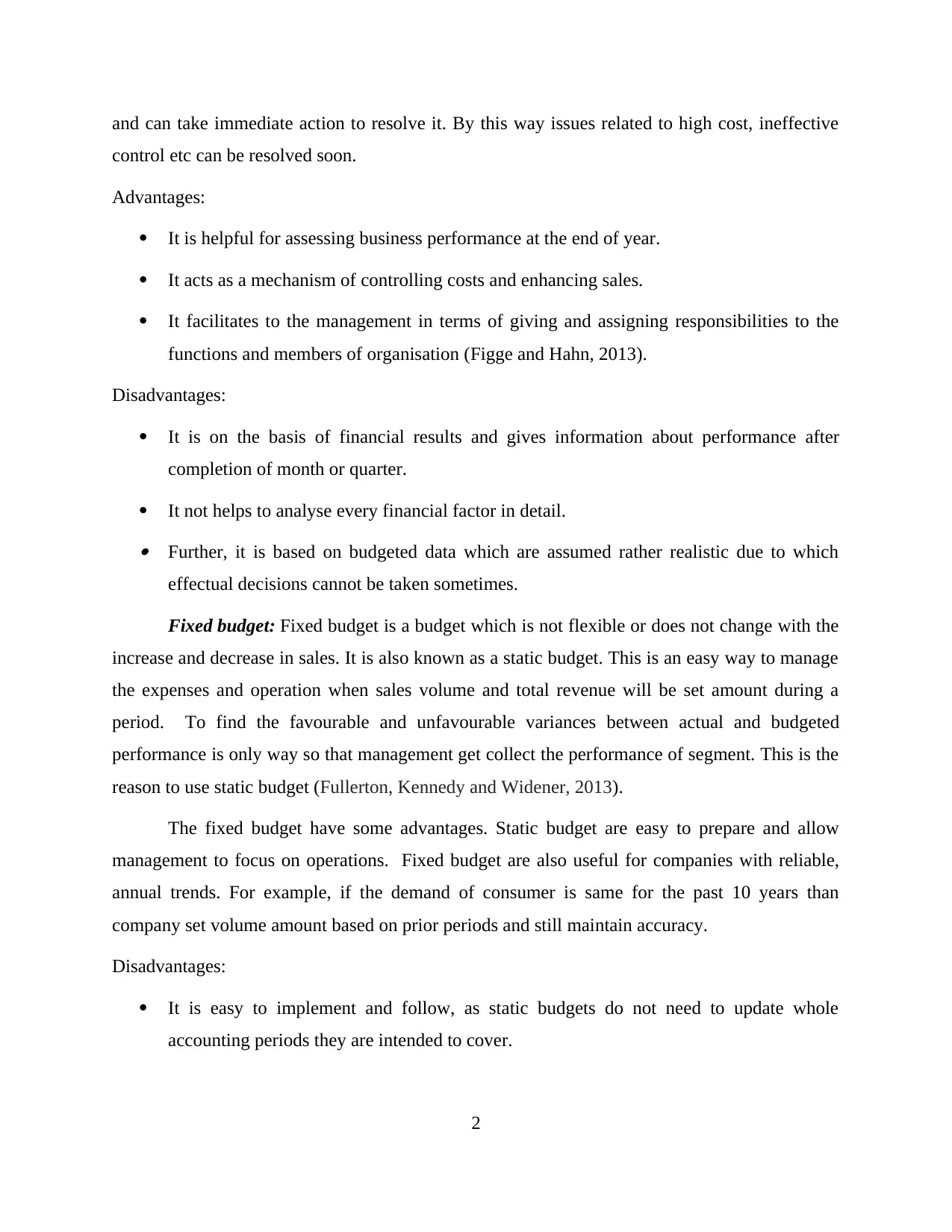
and can take immediate action to resolve it. By this way issues related to high cost, ineffective
control etc can be resolved soon.
Advantages:
It is helpful for assessing business performance at the end of year.
It acts as a mechanism of controlling costs and enhancing sales.
It facilitates to the management in terms of giving and assigning responsibilities to the
functions and members of organisation (Figge and Hahn, 2013).
Disadvantages:
It is on the basis of financial results and gives information about performance after
completion of month or quarter.
It not helps to analyse every financial factor in detail. Further, it is based on budgeted data which are assumed rather realistic due to which
effectual decisions cannot be taken sometimes.
Fixed budget: Fixed budget is a budget which is not flexible or does not change with the
increase and decrease in sales. It is also known as a static budget. This is an easy way to manage
the expenses and operation when sales volume and total revenue will be set amount during a
period. To find the favourable and unfavourable variances between actual and budgeted
performance is only way so that management get collect the performance of segment. This is the
reason to use static budget (Fullerton, Kennedy and Widener, 2013).
The fixed budget have some advantages. Static budget are easy to prepare and allow
management to focus on operations. Fixed budget are also useful for companies with reliable,
annual trends. For example, if the demand of consumer is same for the past 10 years than
company set volume amount based on prior periods and still maintain accuracy.
Disadvantages:
It is easy to implement and follow, as static budgets do not need to update whole
accounting periods they are intended to cover.
2
control etc can be resolved soon.
Advantages:
It is helpful for assessing business performance at the end of year.
It acts as a mechanism of controlling costs and enhancing sales.
It facilitates to the management in terms of giving and assigning responsibilities to the
functions and members of organisation (Figge and Hahn, 2013).
Disadvantages:
It is on the basis of financial results and gives information about performance after
completion of month or quarter.
It not helps to analyse every financial factor in detail. Further, it is based on budgeted data which are assumed rather realistic due to which
effectual decisions cannot be taken sometimes.
Fixed budget: Fixed budget is a budget which is not flexible or does not change with the
increase and decrease in sales. It is also known as a static budget. This is an easy way to manage
the expenses and operation when sales volume and total revenue will be set amount during a
period. To find the favourable and unfavourable variances between actual and budgeted
performance is only way so that management get collect the performance of segment. This is the
reason to use static budget (Fullerton, Kennedy and Widener, 2013).
The fixed budget have some advantages. Static budget are easy to prepare and allow
management to focus on operations. Fixed budget are also useful for companies with reliable,
annual trends. For example, if the demand of consumer is same for the past 10 years than
company set volume amount based on prior periods and still maintain accuracy.
Disadvantages:
It is easy to implement and follow, as static budgets do not need to update whole
accounting periods they are intended to cover.
2
Paraphrase This Document
Need a fresh take? Get an instant paraphrase of this document with our AI Paraphraser

A static budget can offer strong insight into a company's cost and profit when variance
analysis is performed.
It allows to company to see the expenditure and revenues so that it can alter the strategy
going forward.
Static budget don't have build in wiggle room, they help company to control cost and
help to take smart decision (Wagenhofer, 2016).
Advantages:
In this budget lack of flexibility is available.
If company establish budget on certain level of sales volume and the volume increase
can't allocate additional resource to keep it.
This give negative impact on company's revenue stream.
Static budget are based on previous data so that newly formed company have to face the
problems to implementing and establishing plans.
M3 Analysing planning tools along with its application
In order to forecast different types of the budget statements prepared which are related to
the various financial data. Further, such budgets along with example given as below:
Cash budget: It helps to the company in order to derive cash position on monthly,
quarterly or half yearly basis for the further accounting periods. Along with this, cash inflows
and outflows or incomes and expenses are also predetermined by the firm (Hiebl, 2014).
3
analysis is performed.
It allows to company to see the expenditure and revenues so that it can alter the strategy
going forward.
Static budget don't have build in wiggle room, they help company to control cost and
help to take smart decision (Wagenhofer, 2016).
Advantages:
In this budget lack of flexibility is available.
If company establish budget on certain level of sales volume and the volume increase
can't allocate additional resource to keep it.
This give negative impact on company's revenue stream.
Static budget are based on previous data so that newly formed company have to face the
problems to implementing and establishing plans.
M3 Analysing planning tools along with its application
In order to forecast different types of the budget statements prepared which are related to
the various financial data. Further, such budgets along with example given as below:
Cash budget: It helps to the company in order to derive cash position on monthly,
quarterly or half yearly basis for the further accounting periods. Along with this, cash inflows
and outflows or incomes and expenses are also predetermined by the firm (Hiebl, 2014).
3
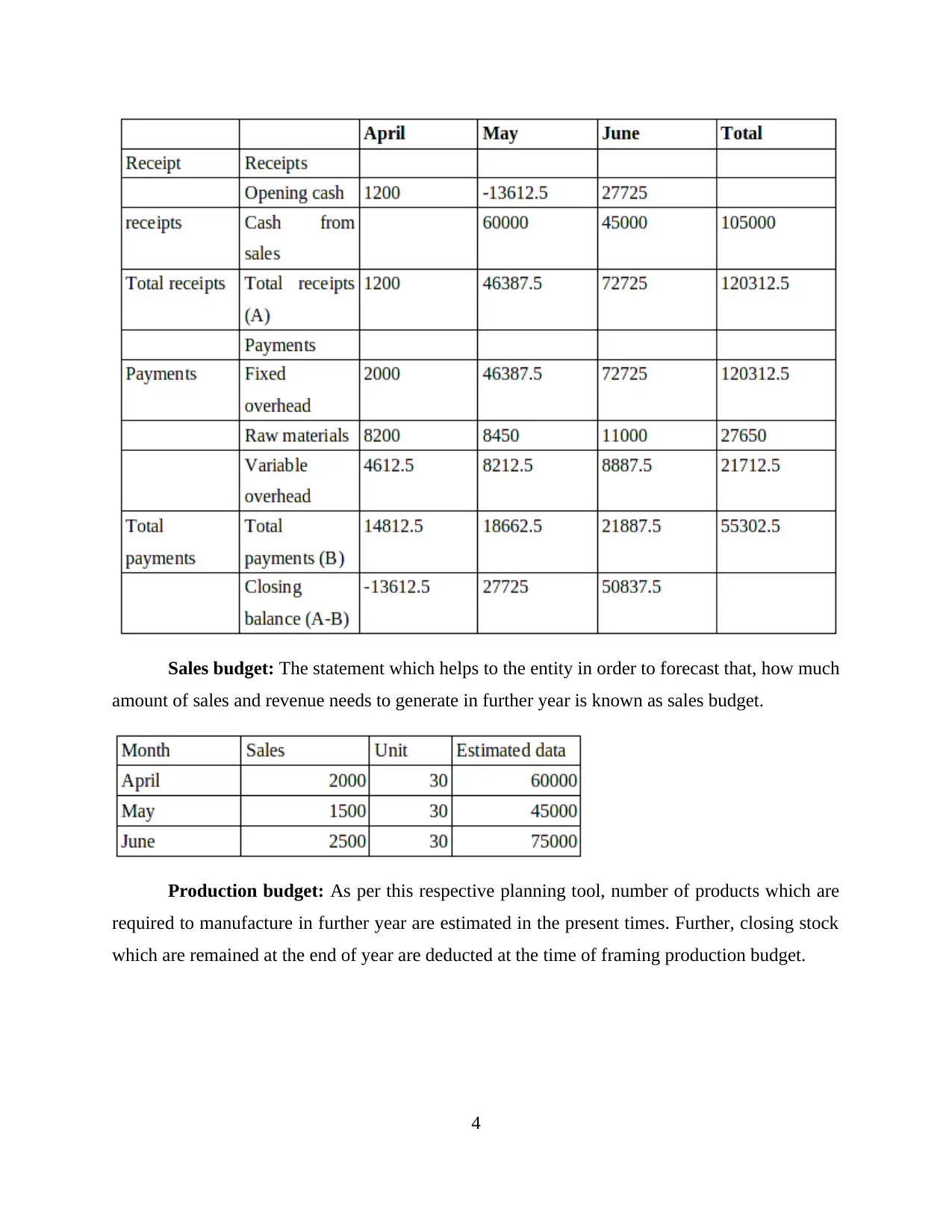
Sales budget: The statement which helps to the entity in order to forecast that, how much
amount of sales and revenue needs to generate in further year is known as sales budget.
Production budget: As per this respective planning tool, number of products which are
required to manufacture in further year are estimated in the present times. Further, closing stock
which are remained at the end of year are deducted at the time of framing production budget.
4
amount of sales and revenue needs to generate in further year is known as sales budget.
Production budget: As per this respective planning tool, number of products which are
required to manufacture in further year are estimated in the present times. Further, closing stock
which are remained at the end of year are deducted at the time of framing production budget.
4
⊘ This is a preview!⊘
Do you want full access?
Subscribe today to unlock all pages.

Trusted by 1+ million students worldwide
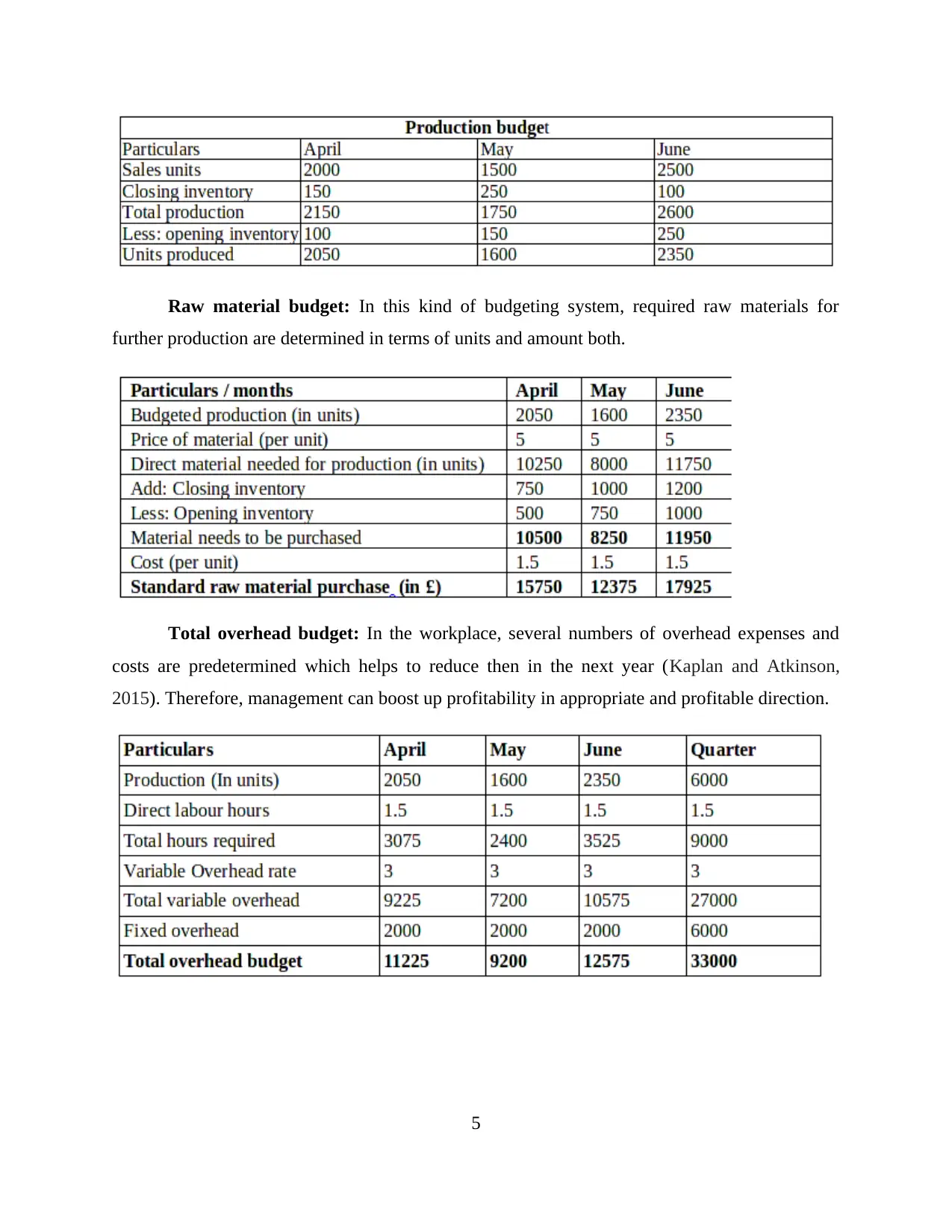
Raw material budget: In this kind of budgeting system, required raw materials for
further production are determined in terms of units and amount both.
Total overhead budget: In the workplace, several numbers of overhead expenses and
costs are predetermined which helps to reduce then in the next year (Kaplan and Atkinson,
2015). Therefore, management can boost up profitability in appropriate and profitable direction.
5
further production are determined in terms of units and amount both.
Total overhead budget: In the workplace, several numbers of overhead expenses and
costs are predetermined which helps to reduce then in the next year (Kaplan and Atkinson,
2015). Therefore, management can boost up profitability in appropriate and profitable direction.
5
Paraphrase This Document
Need a fresh take? Get an instant paraphrase of this document with our AI Paraphraser

P5 Evaluating how companies adapting systems of management accounting for resolving
financial shortfalls
In the management accounting aspect different kinds of systems and approaches framed
which are helpful for the businesses in order to combat financial problems. Further, such systems
developed step by step within some years. Therefore, its historical development along with the
financial issues described as below:
Phase 1:
Under the phase 1, level of competition is very low and all the required data related to
costs and budget are easily produced. This kind of situation is there until financial year 1950
where information of the management accounting not having higher impact on the decision
making process. Due to this, issues regarding to the financial shortfalls and declining
profitability etc. are very low (Luft, 2016).
Phase 2:
The second phase is between financial period 1950 to 1960 because of not having better
control in the firm over the management systems. Due to lack of problems regarding to the
proper and adequate management within working environment, the systems framed. Because of
these issues regarding to cost increasing and profit condition declining etc. come at the company.
Moreover, at this phase, proper systems of management controlling developed and then issues of
cost enhancement solved up to the certain level.
Phase 3:
Third phase of management accounting is developed during the year 1970 and run up to
the early 1980. In this period because of coming modified and highly innovative technologies
level of competition increase within workplace (Messner and et.al., 2016). Due to this, the
business entities need to pay higher amount of the changed technologies which create cost
related issues. Moreover, during this particular phase, financial obstacles regarding to the cost
increasing comes at the consideration. Furthermore, for resolving this problem cost accounting
system of management accounting is taken into account at the majority level.
Phase 4:
6
financial shortfalls
In the management accounting aspect different kinds of systems and approaches framed
which are helpful for the businesses in order to combat financial problems. Further, such systems
developed step by step within some years. Therefore, its historical development along with the
financial issues described as below:
Phase 1:
Under the phase 1, level of competition is very low and all the required data related to
costs and budget are easily produced. This kind of situation is there until financial year 1950
where information of the management accounting not having higher impact on the decision
making process. Due to this, issues regarding to the financial shortfalls and declining
profitability etc. are very low (Luft, 2016).
Phase 2:
The second phase is between financial period 1950 to 1960 because of not having better
control in the firm over the management systems. Due to lack of problems regarding to the
proper and adequate management within working environment, the systems framed. Because of
these issues regarding to cost increasing and profit condition declining etc. come at the company.
Moreover, at this phase, proper systems of management controlling developed and then issues of
cost enhancement solved up to the certain level.
Phase 3:
Third phase of management accounting is developed during the year 1970 and run up to
the early 1980. In this period because of coming modified and highly innovative technologies
level of competition increase within workplace (Messner and et.al., 2016). Due to this, the
business entities need to pay higher amount of the changed technologies which create cost
related issues. Moreover, during this particular phase, financial obstacles regarding to the cost
increasing comes at the consideration. Furthermore, for resolving this problem cost accounting
system of management accounting is taken into account at the majority level.
Phase 4:
6
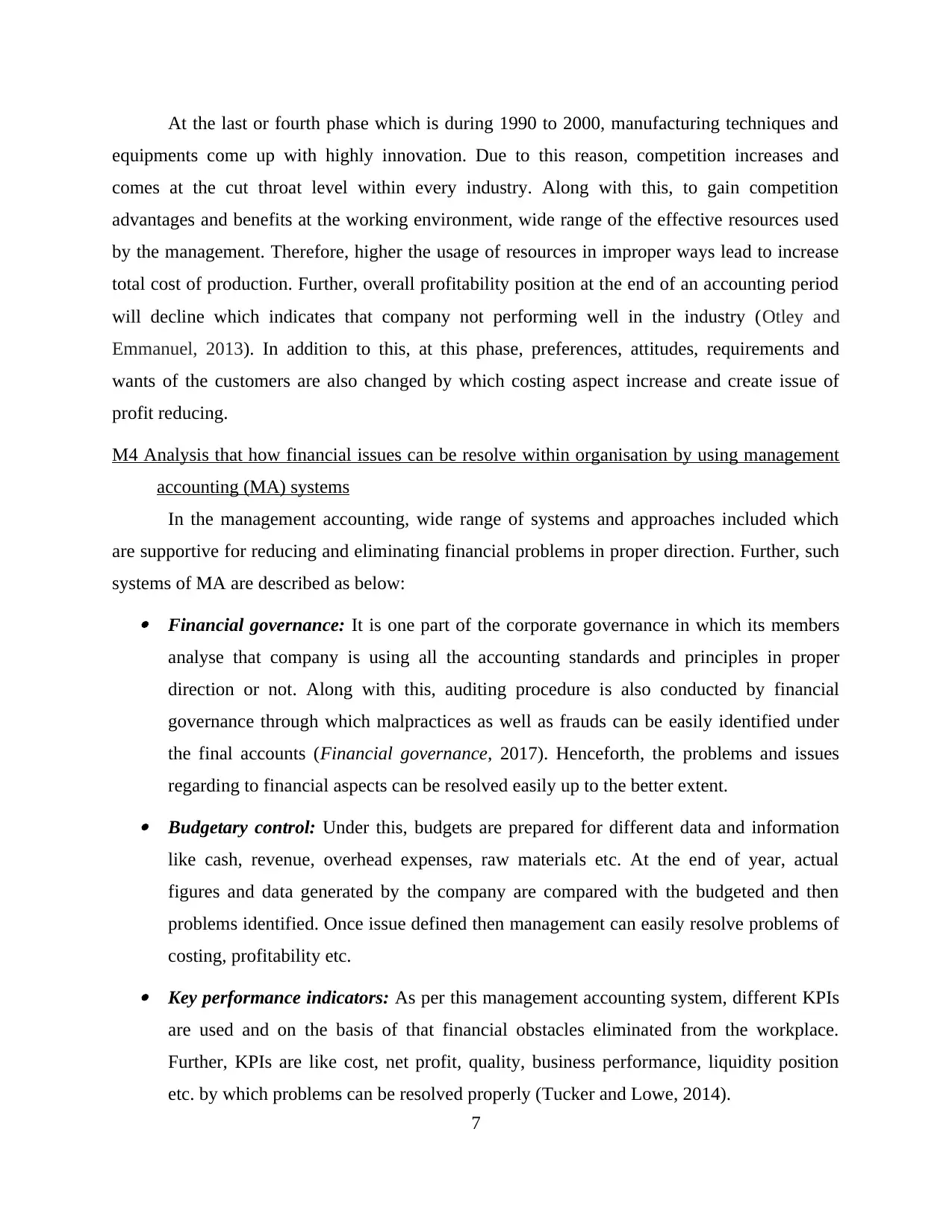
At the last or fourth phase which is during 1990 to 2000, manufacturing techniques and
equipments come up with highly innovation. Due to this reason, competition increases and
comes at the cut throat level within every industry. Along with this, to gain competition
advantages and benefits at the working environment, wide range of the effective resources used
by the management. Therefore, higher the usage of resources in improper ways lead to increase
total cost of production. Further, overall profitability position at the end of an accounting period
will decline which indicates that company not performing well in the industry (Otley and
Emmanuel, 2013). In addition to this, at this phase, preferences, attitudes, requirements and
wants of the customers are also changed by which costing aspect increase and create issue of
profit reducing.
M4 Analysis that how financial issues can be resolve within organisation by using management
accounting (MA) systems
In the management accounting, wide range of systems and approaches included which
are supportive for reducing and eliminating financial problems in proper direction. Further, such
systems of MA are described as below: Financial governance: It is one part of the corporate governance in which its members
analyse that company is using all the accounting standards and principles in proper
direction or not. Along with this, auditing procedure is also conducted by financial
governance through which malpractices as well as frauds can be easily identified under
the final accounts (Financial governance, 2017). Henceforth, the problems and issues
regarding to financial aspects can be resolved easily up to the better extent. Budgetary control: Under this, budgets are prepared for different data and information
like cash, revenue, overhead expenses, raw materials etc. At the end of year, actual
figures and data generated by the company are compared with the budgeted and then
problems identified. Once issue defined then management can easily resolve problems of
costing, profitability etc. Key performance indicators: As per this management accounting system, different KPIs
are used and on the basis of that financial obstacles eliminated from the workplace.
Further, KPIs are like cost, net profit, quality, business performance, liquidity position
etc. by which problems can be resolved properly (Tucker and Lowe, 2014).
7
equipments come up with highly innovation. Due to this reason, competition increases and
comes at the cut throat level within every industry. Along with this, to gain competition
advantages and benefits at the working environment, wide range of the effective resources used
by the management. Therefore, higher the usage of resources in improper ways lead to increase
total cost of production. Further, overall profitability position at the end of an accounting period
will decline which indicates that company not performing well in the industry (Otley and
Emmanuel, 2013). In addition to this, at this phase, preferences, attitudes, requirements and
wants of the customers are also changed by which costing aspect increase and create issue of
profit reducing.
M4 Analysis that how financial issues can be resolve within organisation by using management
accounting (MA) systems
In the management accounting, wide range of systems and approaches included which
are supportive for reducing and eliminating financial problems in proper direction. Further, such
systems of MA are described as below: Financial governance: It is one part of the corporate governance in which its members
analyse that company is using all the accounting standards and principles in proper
direction or not. Along with this, auditing procedure is also conducted by financial
governance through which malpractices as well as frauds can be easily identified under
the final accounts (Financial governance, 2017). Henceforth, the problems and issues
regarding to financial aspects can be resolved easily up to the better extent. Budgetary control: Under this, budgets are prepared for different data and information
like cash, revenue, overhead expenses, raw materials etc. At the end of year, actual
figures and data generated by the company are compared with the budgeted and then
problems identified. Once issue defined then management can easily resolve problems of
costing, profitability etc. Key performance indicators: As per this management accounting system, different KPIs
are used and on the basis of that financial obstacles eliminated from the workplace.
Further, KPIs are like cost, net profit, quality, business performance, liquidity position
etc. by which problems can be resolved properly (Tucker and Lowe, 2014).
7
⊘ This is a preview!⊘
Do you want full access?
Subscribe today to unlock all pages.

Trusted by 1+ million students worldwide
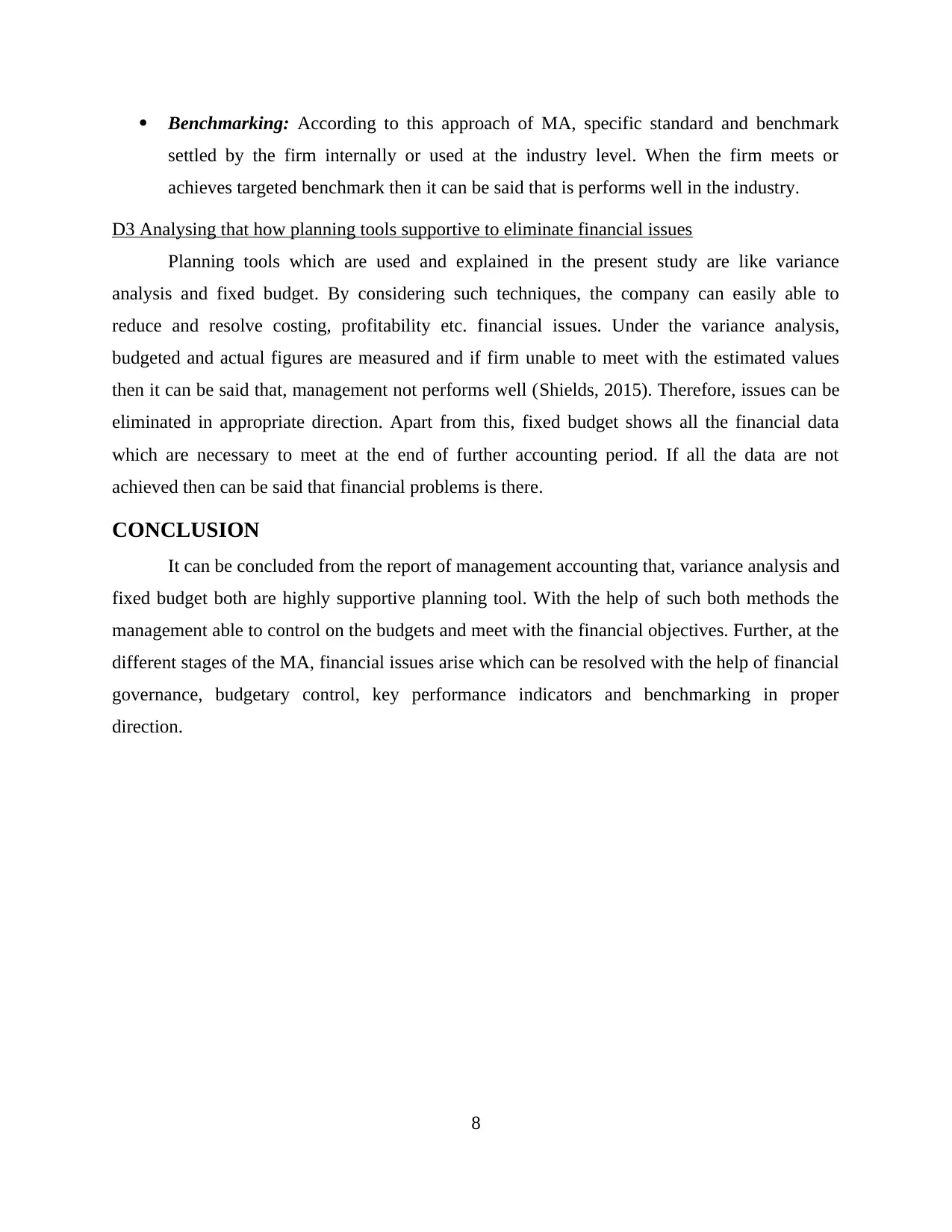
Benchmarking: According to this approach of MA, specific standard and benchmark
settled by the firm internally or used at the industry level. When the firm meets or
achieves targeted benchmark then it can be said that is performs well in the industry.
D3 Analysing that how planning tools supportive to eliminate financial issues
Planning tools which are used and explained in the present study are like variance
analysis and fixed budget. By considering such techniques, the company can easily able to
reduce and resolve costing, profitability etc. financial issues. Under the variance analysis,
budgeted and actual figures are measured and if firm unable to meet with the estimated values
then it can be said that, management not performs well (Shields, 2015). Therefore, issues can be
eliminated in appropriate direction. Apart from this, fixed budget shows all the financial data
which are necessary to meet at the end of further accounting period. If all the data are not
achieved then can be said that financial problems is there.
CONCLUSION
It can be concluded from the report of management accounting that, variance analysis and
fixed budget both are highly supportive planning tool. With the help of such both methods the
management able to control on the budgets and meet with the financial objectives. Further, at the
different stages of the MA, financial issues arise which can be resolved with the help of financial
governance, budgetary control, key performance indicators and benchmarking in proper
direction.
8
settled by the firm internally or used at the industry level. When the firm meets or
achieves targeted benchmark then it can be said that is performs well in the industry.
D3 Analysing that how planning tools supportive to eliminate financial issues
Planning tools which are used and explained in the present study are like variance
analysis and fixed budget. By considering such techniques, the company can easily able to
reduce and resolve costing, profitability etc. financial issues. Under the variance analysis,
budgeted and actual figures are measured and if firm unable to meet with the estimated values
then it can be said that, management not performs well (Shields, 2015). Therefore, issues can be
eliminated in appropriate direction. Apart from this, fixed budget shows all the financial data
which are necessary to meet at the end of further accounting period. If all the data are not
achieved then can be said that financial problems is there.
CONCLUSION
It can be concluded from the report of management accounting that, variance analysis and
fixed budget both are highly supportive planning tool. With the help of such both methods the
management able to control on the budgets and meet with the financial objectives. Further, at the
different stages of the MA, financial issues arise which can be resolved with the help of financial
governance, budgetary control, key performance indicators and benchmarking in proper
direction.
8
Paraphrase This Document
Need a fresh take? Get an instant paraphrase of this document with our AI Paraphraser
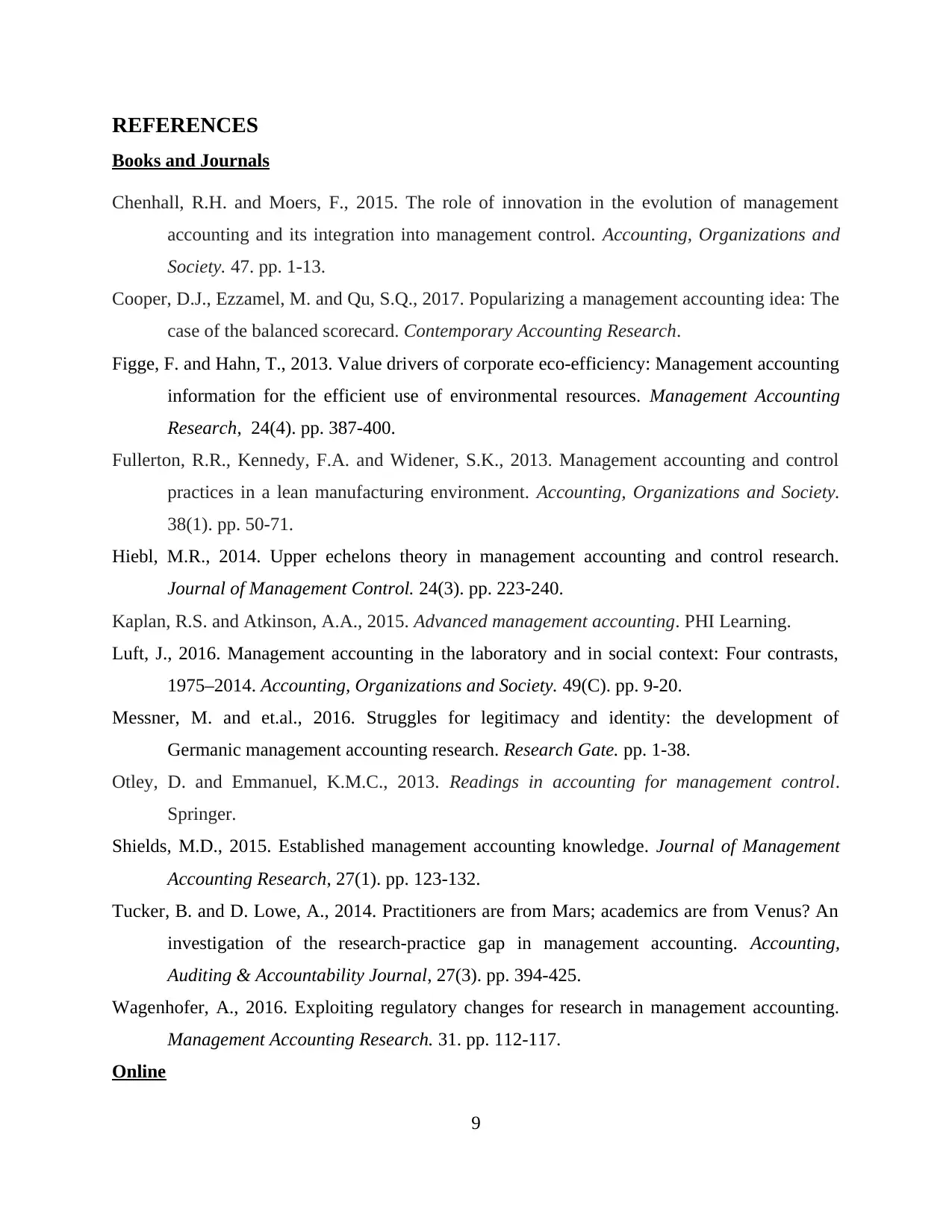
REFERENCES
Books and Journals
Chenhall, R.H. and Moers, F., 2015. The role of innovation in the evolution of management
accounting and its integration into management control. Accounting, Organizations and
Society. 47. pp. 1-13.
Cooper, D.J., Ezzamel, M. and Qu, S.Q., 2017. Popularizing a management accounting idea: The
case of the balanced scorecard. Contemporary Accounting Research.
Figge, F. and Hahn, T., 2013. Value drivers of corporate eco-efficiency: Management accounting
information for the efficient use of environmental resources. Management Accounting
Research, 24(4). pp. 387-400.
Fullerton, R.R., Kennedy, F.A. and Widener, S.K., 2013. Management accounting and control
practices in a lean manufacturing environment. Accounting, Organizations and Society.
38(1). pp. 50-71.
Hiebl, M.R., 2014. Upper echelons theory in management accounting and control research.
Journal of Management Control. 24(3). pp. 223-240.
Kaplan, R.S. and Atkinson, A.A., 2015. Advanced management accounting. PHI Learning.
Luft, J., 2016. Management accounting in the laboratory and in social context: Four contrasts,
1975–2014. Accounting, Organizations and Society. 49(C). pp. 9-20.
Messner, M. and et.al., 2016. Struggles for legitimacy and identity: the development of
Germanic management accounting research. Research Gate. pp. 1-38.
Otley, D. and Emmanuel, K.M.C., 2013. Readings in accounting for management control.
Springer.
Shields, M.D., 2015. Established management accounting knowledge. Journal of Management
Accounting Research, 27(1). pp. 123-132.
Tucker, B. and D. Lowe, A., 2014. Practitioners are from Mars; academics are from Venus? An
investigation of the research-practice gap in management accounting. Accounting,
Auditing & Accountability Journal, 27(3). pp. 394-425.
Wagenhofer, A., 2016. Exploiting regulatory changes for research in management accounting.
Management Accounting Research. 31. pp. 112-117.
Online
9
Books and Journals
Chenhall, R.H. and Moers, F., 2015. The role of innovation in the evolution of management
accounting and its integration into management control. Accounting, Organizations and
Society. 47. pp. 1-13.
Cooper, D.J., Ezzamel, M. and Qu, S.Q., 2017. Popularizing a management accounting idea: The
case of the balanced scorecard. Contemporary Accounting Research.
Figge, F. and Hahn, T., 2013. Value drivers of corporate eco-efficiency: Management accounting
information for the efficient use of environmental resources. Management Accounting
Research, 24(4). pp. 387-400.
Fullerton, R.R., Kennedy, F.A. and Widener, S.K., 2013. Management accounting and control
practices in a lean manufacturing environment. Accounting, Organizations and Society.
38(1). pp. 50-71.
Hiebl, M.R., 2014. Upper echelons theory in management accounting and control research.
Journal of Management Control. 24(3). pp. 223-240.
Kaplan, R.S. and Atkinson, A.A., 2015. Advanced management accounting. PHI Learning.
Luft, J., 2016. Management accounting in the laboratory and in social context: Four contrasts,
1975–2014. Accounting, Organizations and Society. 49(C). pp. 9-20.
Messner, M. and et.al., 2016. Struggles for legitimacy and identity: the development of
Germanic management accounting research. Research Gate. pp. 1-38.
Otley, D. and Emmanuel, K.M.C., 2013. Readings in accounting for management control.
Springer.
Shields, M.D., 2015. Established management accounting knowledge. Journal of Management
Accounting Research, 27(1). pp. 123-132.
Tucker, B. and D. Lowe, A., 2014. Practitioners are from Mars; academics are from Venus? An
investigation of the research-practice gap in management accounting. Accounting,
Auditing & Accountability Journal, 27(3). pp. 394-425.
Wagenhofer, A., 2016. Exploiting regulatory changes for research in management accounting.
Management Accounting Research. 31. pp. 112-117.
Online
9

Financial governance, 2017. [online]. Available through:
<http://www.mango.org.uk/guide/financialgovernance> [Accessed on 3rd August 2017]
10
<http://www.mango.org.uk/guide/financialgovernance> [Accessed on 3rd August 2017]
10
⊘ This is a preview!⊘
Do you want full access?
Subscribe today to unlock all pages.

Trusted by 1+ million students worldwide
1 out of 12
Related Documents
Your All-in-One AI-Powered Toolkit for Academic Success.
+13062052269
info@desklib.com
Available 24*7 on WhatsApp / Email
![[object Object]](/_next/static/media/star-bottom.7253800d.svg)
Unlock your academic potential
Copyright © 2020–2025 A2Z Services. All Rights Reserved. Developed and managed by ZUCOL.




